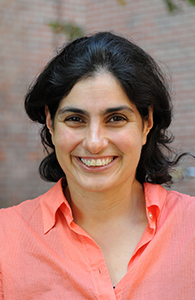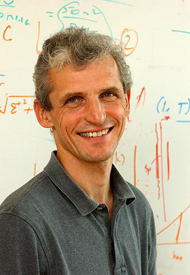Getaran dan Gelombang
Instructor/speaker: Prof. Walter Lewin
Free Downloads
Video
- iTunes U (MP4 - 164MB)
- Internet Archive (MP4 - 164MB)
Free Streaming
Pengembangan Perkuliahan
1. Buatlah sebuah Esai mengenai materi perkuliahan ini
2. Buatlah sebuah kelompok berjumlah 5 orang untuk menganalisis materi perkuliahan ini
3. Lakukan Penelitian Sederhana dengan kelompok tersebut
4. Hasilkan sebuah produk yang dapat digunakan oleh masyarakat
5. Kembangkan produk tersebut dengan senantiasa meningkatkan kualitasnyab.NERGIS MAVALVALA
Professor of Physics
 | Name: Nergis Mavalvala Title(s): Professor of Physics Email: nergis@ligo.mit.edu Phone: (Office) 617-253-5657 (Lab) 617-253-4824 Assistant: Marie Woods (617) 253-4824 Address: Massachusetts Institute of Technology Related Links: |
Area of Research:
Division of Astrophysics: Gravitational Waves and Quantum Measurement
Research Interests
Professor Mavalvala's research focuses on interferometric Gravitational Waves and Quantum Measurement. The major U.S. effort in this field is LIGO (Laser Interferometer Gravitational Wave Observatory), scheduled to come on the air in 2002. The gravitational waves that LIGO and its international counterparts expect to detect are ripples in the spacetime fabric caused by the motion of compact, massive astrophysical objects. Since the nature of gravitation is inherently different from electromagnetism, gravitational wave astrophysics has the potential of providing a radically different view of the universe, including direct observation of massive dark matter, large-scale nuclear matter and a test of strong-field gravitation.
The greatest challenge facing current detectors is achieving a sensitivity that is commensurate with the signal strengths expected from typical sources, such as coalescing neutron star binaries. In its first incarnation, LIGO is expected to reach a strain sensitivity of 10-21 at 100 Hz. Difficulties in estimating gravitational wave strain from astrophysical objects based on observations made using the electromagnetic spectrum further highlight the need for improved sensitivity in the near future.
Consequently, even as the initial LIGO detectors begin operation, research and development for second-generation detectors is underway. Advanced LIGO detectors may be installed as early as 2006. In addition, a space-based gravitational- wave interferometer-the Laser Interferometer Space Antenna (LISA) - is planned for launch in 2011. All of these developments present unique and diverse opportunities in this young field. Professor Mavalvala's research activities, in collaboration with the LIGO group at MIT, will include instrument development, precision measurements at fundamental quantum limits, and data analysis.
Biographical Sketch
Professor Nergis Mavalvala joined the Physics faculty at MIT in January 2002. Before that, she was a postdoctoral associate and then a research scientist at Caltech, working on the Laser Interferometric Gravitational Wave Observatory (LIGO). She has been involved with LIGO since her early years in graduate school at MIT and her primary research has been in instrument development for interferometric gravitational-wave detectors. Professor Mavalvala received a Ph.D. in Physics from MIT in 1997, and a B.A. in Physics and Astronomy from Wellesley College in 1990.
Selected Publications
- "Measurement of radiation-pressure-induced optomechanical dynamics in a suspended Fabry-Perot cavity," T. Corbitt, D. Ottaway, E. Innerhofer, J. Pelc, and N. Mavalvala, Phys. Rev. A 74, 021802 (2006).
- "A squeezed state source using radiation pressure induced rigidity," T. Corbitt, Y. Chen, F. Khalili, D. Ottaway, S. Vyatchanin, S. Whitcomb, and N. Mavalvala, Phys. Rev. A 73, 023801 (2006).
- "Lock acquisition of a gravitational wave interferometer," M. Evans, N. Mavalvala, P. Fritschel, R. Bork, B. Bhawal, R. Gustafson, W. Kells, M. Landry, D. Sigg, R. Weiss, S. Whitcomb, H. Yamamoto, accepted for publication in Opt. Lett. (2002).
- "Readout and control of a power-recycled gravitational-wave antenna," P. Fritschel, R. Bork, G. González, N. Mavalvala, D. Ouimette, H. Rong, D. Sigg, and M. Zucker, Appl. Opt. 40, 4988 (2001).
- "High gain power-recycling of a Fabry-Perot Michelson interferometer for a gravitational wave antenna," S. Sato, M. Ohashi, M-K. Fujimoto, K. Waseda, S. Miyoki, N. Mavalvala, and H. Yamamoto, Appl. Opt. 39, 4616 (2000).
- "Principles of calculating the dynamical response of misaligned complex resonant optical interferometers," D. Sigg and N. Mavalvala, J. Opt. Soc. Am. A 17, 1642 (2000).
- "Determination and optimization of mode matching into optical cavities using heterodyne detection," G. Mueller, Q. Shu, R. Adhikari, D. Tanner, D. Reitze, D. Sigg, N. Mavalvala and J. Camp, Opt. Lett. 25, 266 (2000).
- "Experimental test of an alignment sensing scheme for a gravitational-wave interferometer," N. Mavalvala, D. Sigg and D. Shoemaker, Appl. Opt. 37, 7906 (1998).
c. WOLFGANG KETTERLE
John D. MacArthur Professor of Physics
Associate Director, Research Laboratory of Electronics
Director, MIT-Harvard Center for Ultracold Atoms
2001 Nobel Laureate
 | Name: Wolfgang Ketterle Title(s): John D. MacArthur Professor of Physics Email: ketterle@mit.edu Phone: (617) 253-6815 Assistant: Joanna M. Keseberg (617) 253-6830 Address: Massachusetts Institute of Technology Related Links: |
Area of Physics:
Atomic, Molecular, and Optical Physics
News:
- "MIT researchers create a continuous source of coherent atoms" (MIT News Office, May 16, 2002)
- The Nobel Prize in Physics 2001 (The Official Web Site of the Nobel Foundation)
View the Lectures:
- "When Atoms Behave as Waves: Bose-Einstein Condensation and the Atom Laser" (Stockholm University, Sweden, December 8, 2001)
- The MIT Department of Physics Colloquium presents the 2001 Nobel Prize in Physics Lecture: "Bose-Einstein Condensates: the Coldest Matter in the Universe"
Research Interests
Professor Ketterle's research is in atomic physics and laser spectroscopy, particularly in the area of laser cooling and trapping of neutral atoms with the goal of exploring new aspects of ultracold atomic matter. Since the discovery of gaseous Bose-Einstein condensation, large samples of ultracold atoms at nanokelvin temperatures are available. His research group uses such samples for various directions of research. Bose-Einstein condensates are a new quantum fluid. The interactions among the atoms make them an intriguing novel many-body system. Aspects of interest are sound, superfluidity, and properties of miscible and immiscible multi-component condensates. These topics are interdisciplinary with condensed matter physics.
The coherence properties of the condensate are exploited in the field of atom optics. Coherent beams of atoms extracted from the condensate ("atom lasers") are analogous to optical laser beams. Ketterle's research group has used Bose-Einstein condensates as amplifiers for light and for atoms. A third direction is precision measurements. The unprecedented control over the position and velocity of atoms provided by Bose-Einstein condensates is exploited for high precision atom interferometry.
Biographical Sketch
Wolfgang Ketterle received a diploma (equivalent to a master's degree) from the Technical University of Munich (1982), and a Ph.D. in Physics from the University of Munich (1986). After postdoctoral work at the Max-Planck Institute for Quantum Optics in Garching, Germany, the University of Heidelberg and at MIT, he joined the physics faculty at MIT (1993), where he is now the John D. MacArthur Professor of Physics. He does experimental research in atomic physics and laser spectroscopy and focuses currently on Bose-Einstein condensation in dilute atomic gases. He was among the first scientists to observe this phenomenon in 1995, and realized the first atom laser in 1997. His earlier research was in molecular spectroscopy and combustion diagnostics.
His awards include a David and Lucile Packard Fellowship (1996), the Rabi Prize of the American Physical Society (1997), the Gustav-Hertz Prize of the German Physical Society (1997), the Discover Magazine Award for Technological Innovation (1998), the Fritz London Prize in Low Temperature Physics (1999), the Dannie-Heineman Prize of the Academy of Sciences, Göttingen, Germany (1999), the Benjamin Franklin Medal in Physics (2000), and the Nobel Prize in Physics (2001, together with E.A. Cornell and C.E. Wieman).
For additional biographical information on Professor Ketterle, see his autobiography written for the Nobel Foundation.
Selected Publications
Please visit the Ketterle Group Home Page for Professor Ketterle's most recent list of publications.
2. Para Dosen Pendidikan Fisika, FPMIPA, Universitas Pendidikan Indonesia.Terima Kasih Semoga Bermanfaat dan mohon Maaf apabila ada kesalahan.





Tidak ada komentar:
Posting Komentar